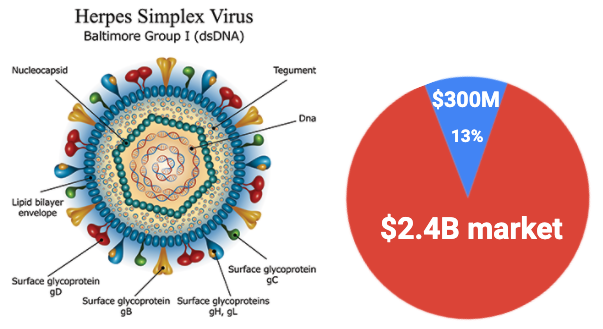Maxwell Peptoids Active Against Herpes Simplex 1 (HSV-1)
Herpes simplex virus-1 (HSV-1) is an enveloped, double stranded, DNA virus that is transmitted via human to human contact, infecting a majority of people <50 years old worldwide [1]. Symptomatic patients have painful, recurrent, oral lesions. HSV-1 can also infect the eyes and is a leading cause of corneal infectious blindness in developed countries [2]. Currently, there is no cure for HSV-1 infections and those afflicted remain so for life.
Illustration: Herpes Simplex Virus Architecture and Market Size (2027)
Human Cathelicidin Antimicrobial Peptides, or more simply “LL-37”, are found in human white blood cells and help the body attack viruses. Maxwell’s peptoids mimic the structure and other functional characteristics of LL-37. These drug candidates have a well-published history of broad spectrum anti-infectives activity in high-impact journals.
Maxwell Peptoids are biomimetic, synthetic foldamers that have amino acid side chains attached at the nitrogen, instead of at the carbon. This design makes our peptoids resistant to the protease enzymes which many pathogens use to destroy carbon-based immune peptides.
To determine the in vitro activity of Maxwell Peptoids™ against HSV-1, Professor Diamond’s Lab (University Of Louisville) incubated purified virus with Maxwell’s Peptoids ™ for 2 hours at 37oC before infecting cultured oral epithelial cells (OKF6/TERT-1). This human cell assay is a robust model for HSV-1 oral infections. After 24 hours in culture, Professor Diamond’s Lab measured the amount of HSV-1 DNA in the cells, by Quantitative PCR. 5 of the 9 peptoids tested showed promising activity versus control. The results showed a reduction in intracellular HSV-1 viral load indicating that the peptoid mechanism of action is direct and virucidal.
Maxwell Peptoids™ from the initial screening experiment were further evaluated for A) dose dependency and B) time dependency (figure 1). The results show strong virucidal activity, comparable to the naturally occurring LL-37. When the peptoids were added to the OKF6/TERT-1 cultured cells alone, minimal cytotoxicity was observed, demonstrating potential for a safety margin in vivo.
More research is underway to specifically define the mechanism of action, however these results clearly indicate that these peptoids are stable, effective antiviral agents able to treat and/or prevent HSV-1 infections.
References:
World Health Organization. (2015, October 25). Globally, an estimated two-thirds of the population under 50 are infected with herpes simplex virus type 1.
https://www.who.int/news-room/detail/28-10-2015-globally-an-estimated-two-thirds-of-the-population-under-50-are-infected-with-herpes-simplex-virus-type-1Burn, C., Ramsey, N., Garforth, S. J., Almo, S., Jacobs Jr, W. R., & Herold, B. C. (2018). A herpes simplex virus (HSV)-2 single-cycle candidate vaccine deleted in glycoprotein D protects male mice from lethal skin challenge with clinical isolates of HSV-1 and HSV-2. The Journal of infectious diseases, 217(5), 754-758. https://doi.org/10.1093/infdis/jix628


